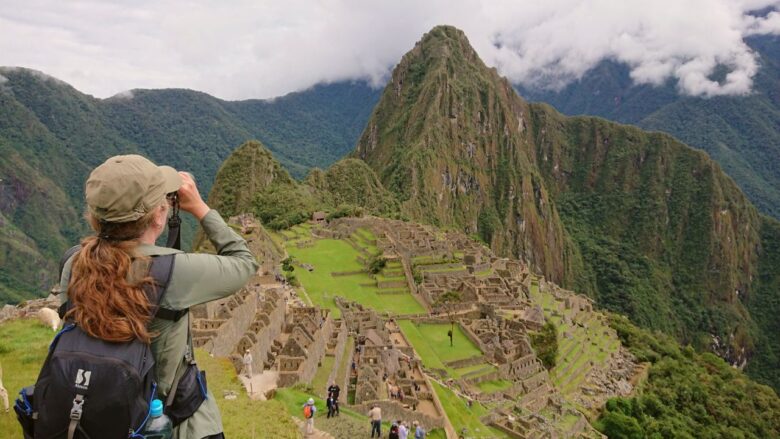This post is also available in: Dansk
All photos © Bente Steffensen and Uffe Damm Andersen, unless otherwize stated.
On the tourist route
”Hola hola!” came the voice of our very enthusiastic guide from Peru Hop through the speakers on the bus, as he started on the practical information about the bus ride to the port town Paracas. Wearing the company’s red t-shirt, the cap turned backwards, he told about the guided tours you could book and take part in.
In March 2019 after a week’s stay in the capital Lima, we were on our way through Peru. A trip to offer desert racing, mysterious lines and the summer residence of the Incas – or to put it in other words: we took the tourist route.
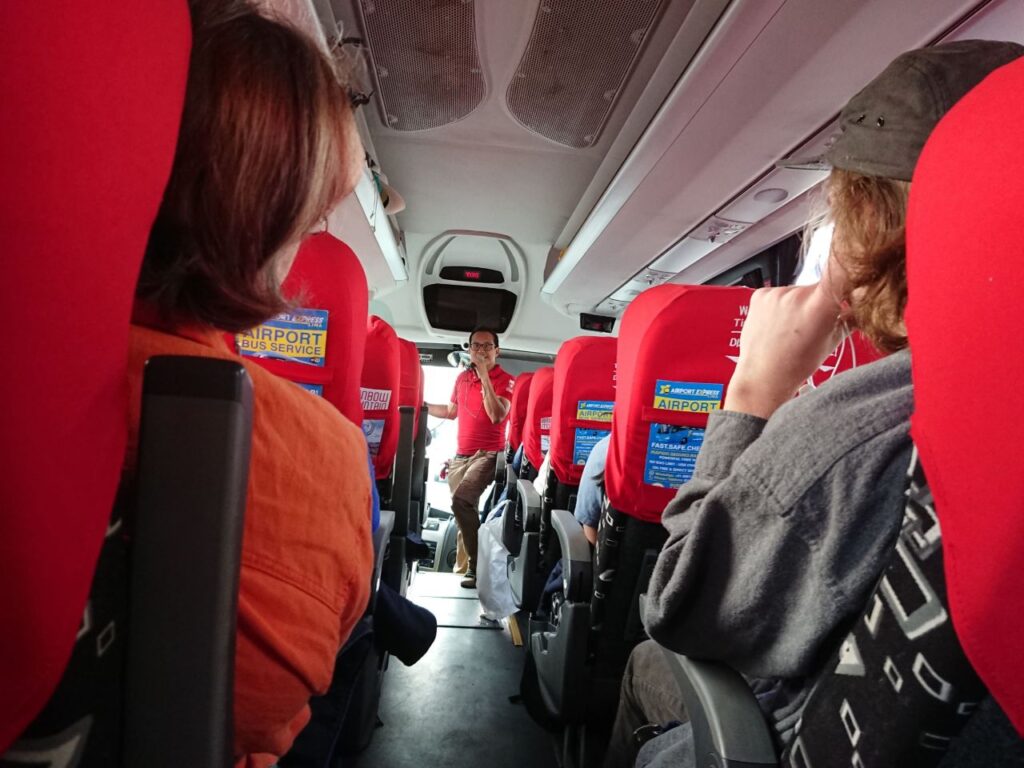
Don’t be a typical tourist…?
The motto of Peru Hop is “Don’t be a typical tourist”. The mode of travel is probably a little different from the “typical” tourist groups, where everything is booked in advance from home. And no, it wasn’t that type of tourists we met on our tours with Peru Hop.
There was the young Eastern European couple who were on their first major trip together. There were the three young Danish girls who were on the “compulsory” educational journey after high school. There were the four German men in their early 30s, and then there was the ageing American hippie, who 50 years ago definitely had been at Woodstock, but probably wouldn’t have been able to remember more than a few hazy images. And finally, there was the middle-aged couple from Denmark who had taken a year out of the calendar to go birding in Latin America.
A mixed party – and then again, not. It was predominantly tourists belonging to the backpacker segment – primarily young people from Europe and North America, traveling with Peru Hop. Some traveled for months while others traveled for a few weeks or maybe just one.
But it was probably still the typical (backpacker) tourists we met. It was the same sights and tours that our fellow travelers on the buses had visited or were to visit and that all other tourists in Peru visit. One thing was for sure, this was the first time on our trip that we were on the tourist route in South America.
Easy and flexible
Peru Hop was started in 2013 with the idea of creating an alternative way to be independent and still travel safely around Peru. And no matter what, there is no doubt that traveling with Peru Hop is easy, safe and flexible. You can read more about Peru Hop on their website
It is a hop-on, hop-off system where you can travel by bus – and it is some nice buses – from Lima with several stops along the way and end the journey in La Paz, Bolivia. You book the travel online and you can even do it from day-to-day. It’s good if for some reason you want to stay longer at one of the destinations – for example if you just have to have one more party. Or in Arequipa you decide to take a day trip to the Colca Canyon before heading on to Cusco.
Along the way, the guides will help you book accommodation or tours if you have not done so yet. And of course, you can get a discount on dinner at some of the local restaurants or “a free beer” at selected bars.
We traveled with Peru Hop from Lima with stops and overnight stays in Paracas, Huacachina, Arequipa and ended in Cusco. And we have to say that it worked perfectly, and the guides were welcoming and helpful. It may seem a bit chaotic when one group is waiting for the bus to the next stop while others are waiting for the bus to take them on today’s guided tour of the local area. Even when we experienced “overbooking” they quickly provided an extra bus and coordinated bus exchange.
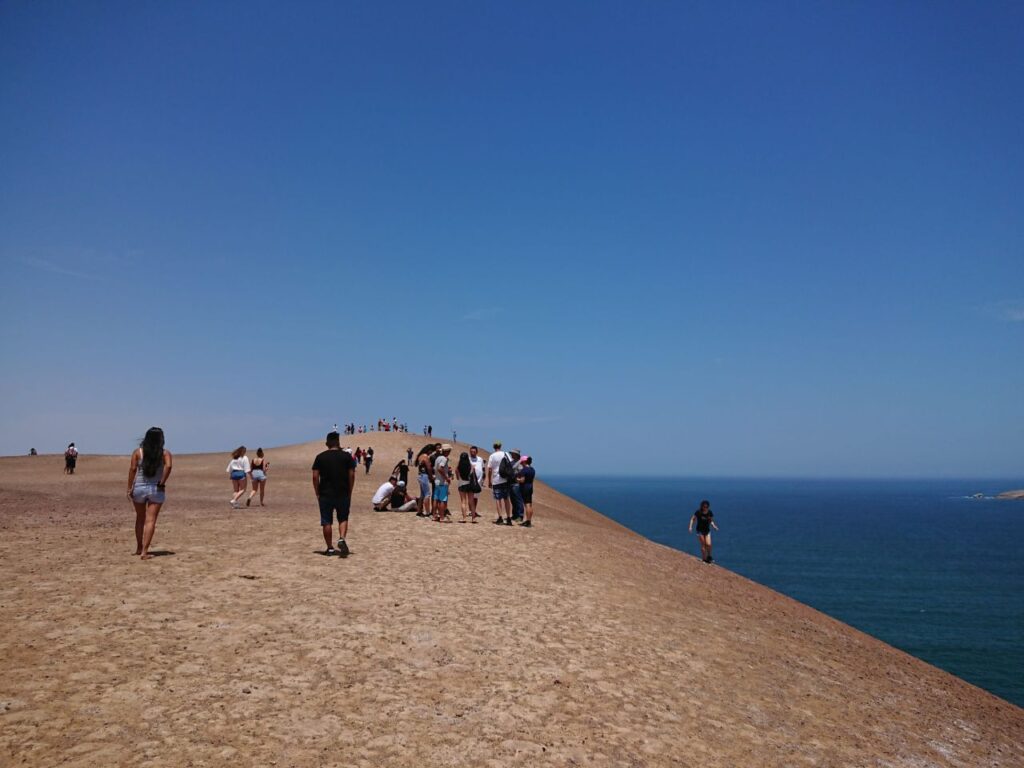
Penguins off Paracas
Approximately three hours drive south of Lima you will find the small port town of Paracas. Every year, the town in the Ica region is visited by many tourists. The town is the starting point for trips to the Ballestas Islands and Paracas National Reserve.
The Ballestas Islands – also called “the poor man’s Galapagos” – were our goal. On the islands, which it takes approx. 45 minutes to sail out to, there are a lot of sea lions and birds. In addition to three species of cormorants, Inca Terns and boobies, there are also penguins – Humboldt Penguins. We had seen two penguins previously (read: Three Intense Days of Birding in Peru) but only briefly, and now we were hoping to see them better.
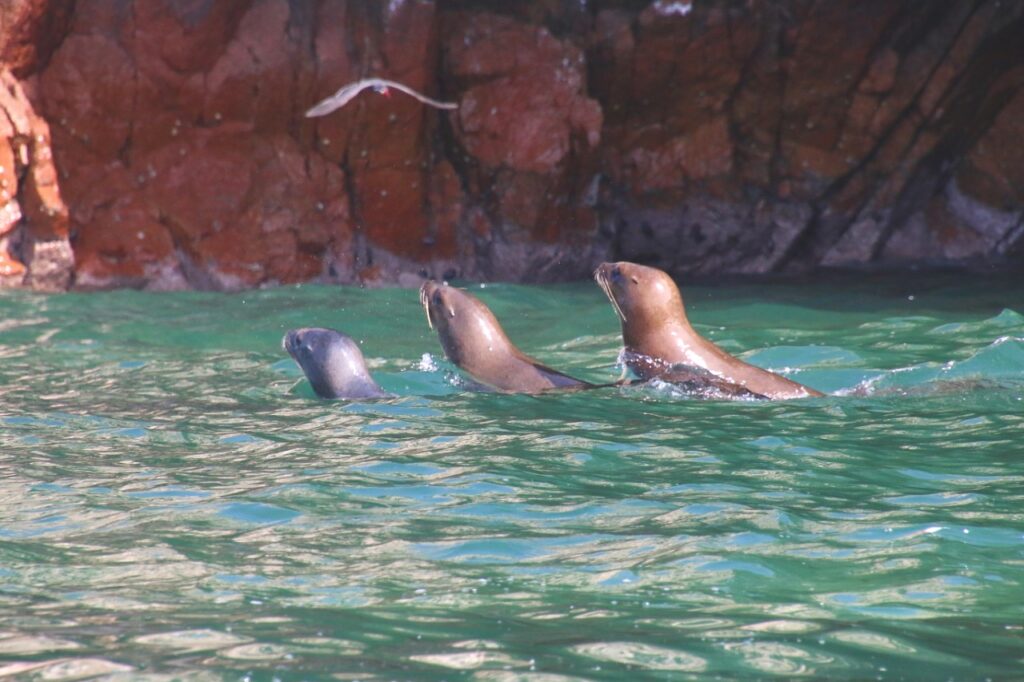
Through Peru Hop we had booked a morning trip out to the islands. The whole trip takes two hours and takes place in large high-speed motorboats. You are not allowed to go ashore on the islands which are designated as a nature reserve, but you sail close to the rocky coasts to get reasonably close to the birds and sea lions.
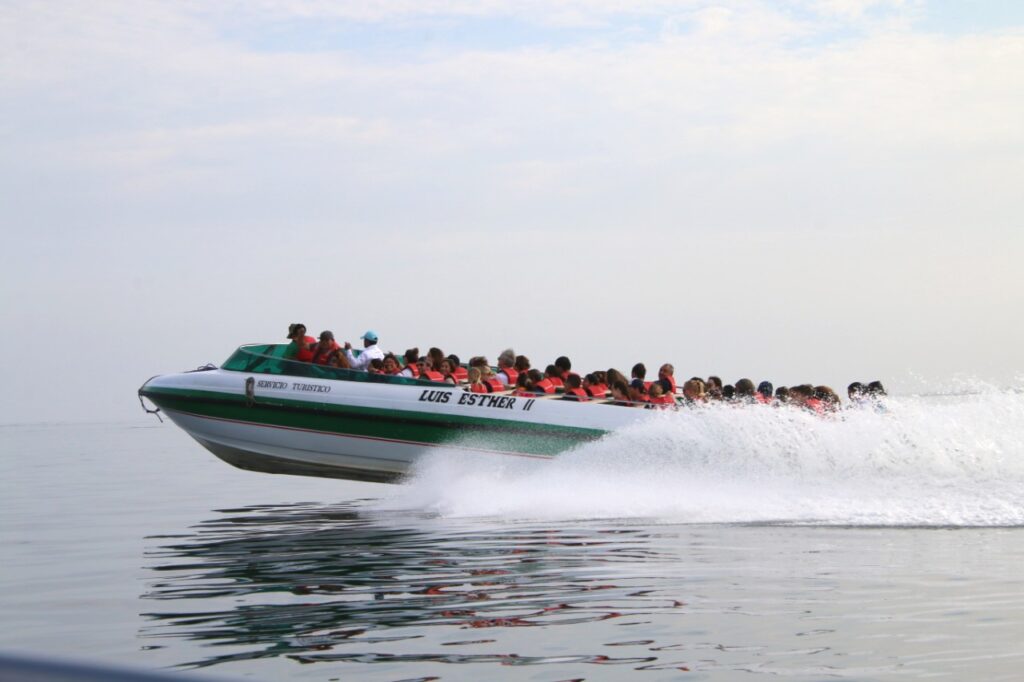
Although the guide on board told us about the history of the islands and what birds you saw, there was no birding. It was a sightseeing trip akin to a harbor cruise in Copenhagen (or other major cities), but it was the only way we could get out on something reminiscent of a pelagic birding trip.
Despite being on a boat packed with non-birder tourists, we saw lots of birds on the trip and there were a few penguins as well.
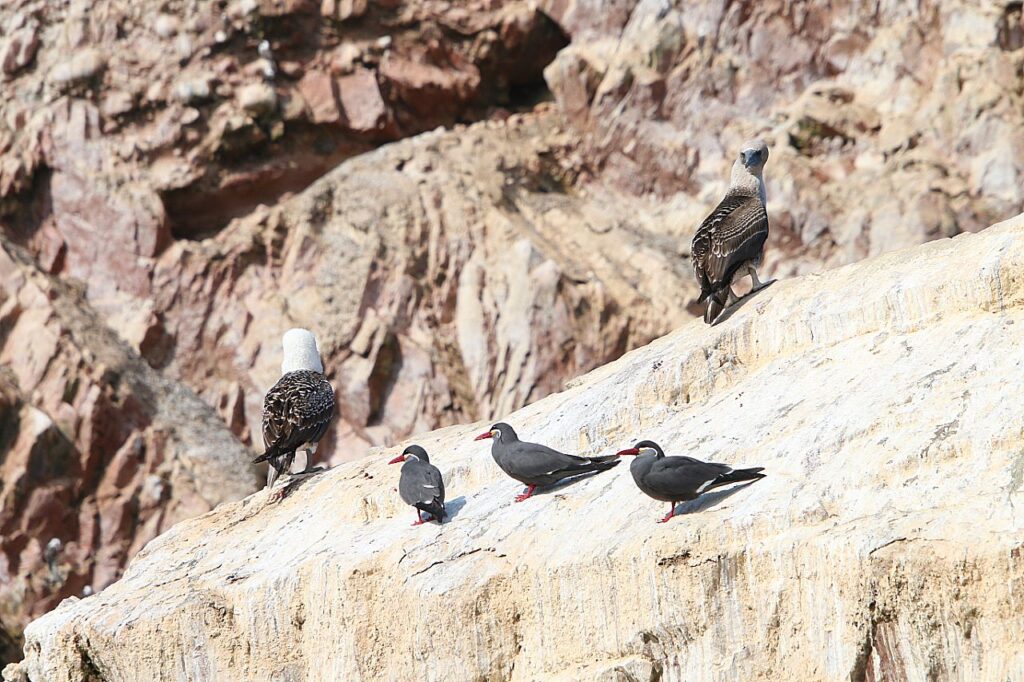

Desert racing and Sandboarding
An hours drive from Paracas is the very small town of Huacachina. It is also called Huacachina Oasis because the city is like a small oasis surrounded by some of South America’s largest dunes.
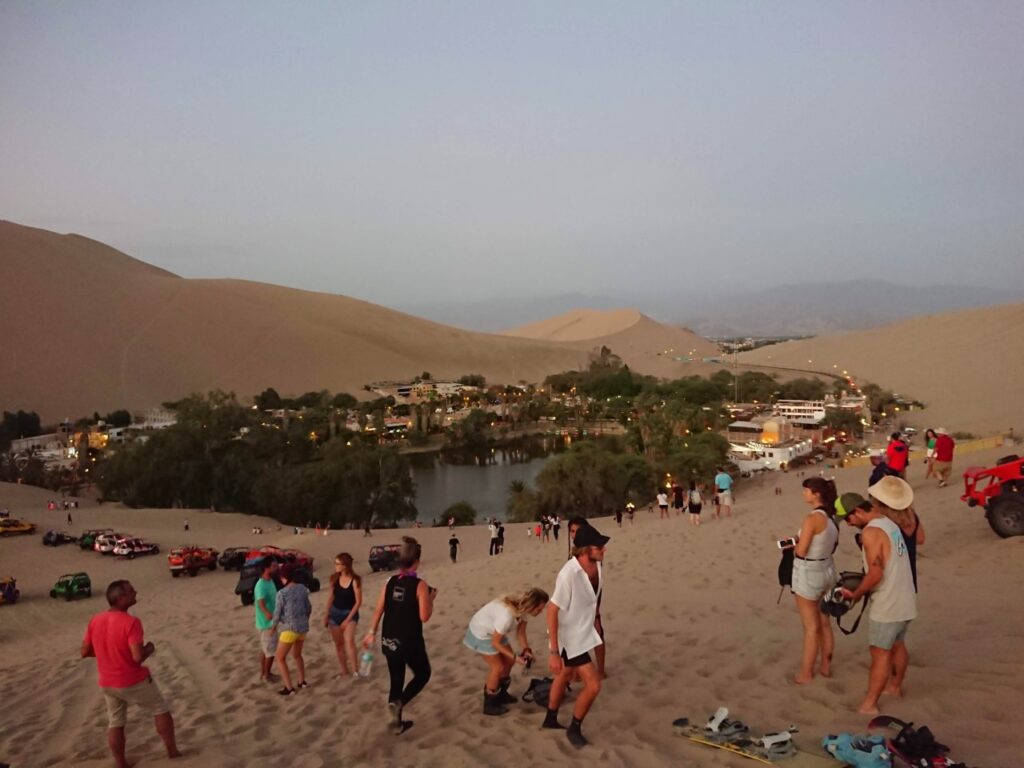
I might as well say it right away – it’s not a place for us! All around the little lake, there were restaurants, bars and hotels and hostels in all price ranges. We were only there because we traveled with Peru Hop and therefore had to stay overnight.
What to do in Huacachina? You go desert racing, sand boarding – and then of course, you party! If we had been in doubt before, we weren’t anymore – we were on the tourist route.
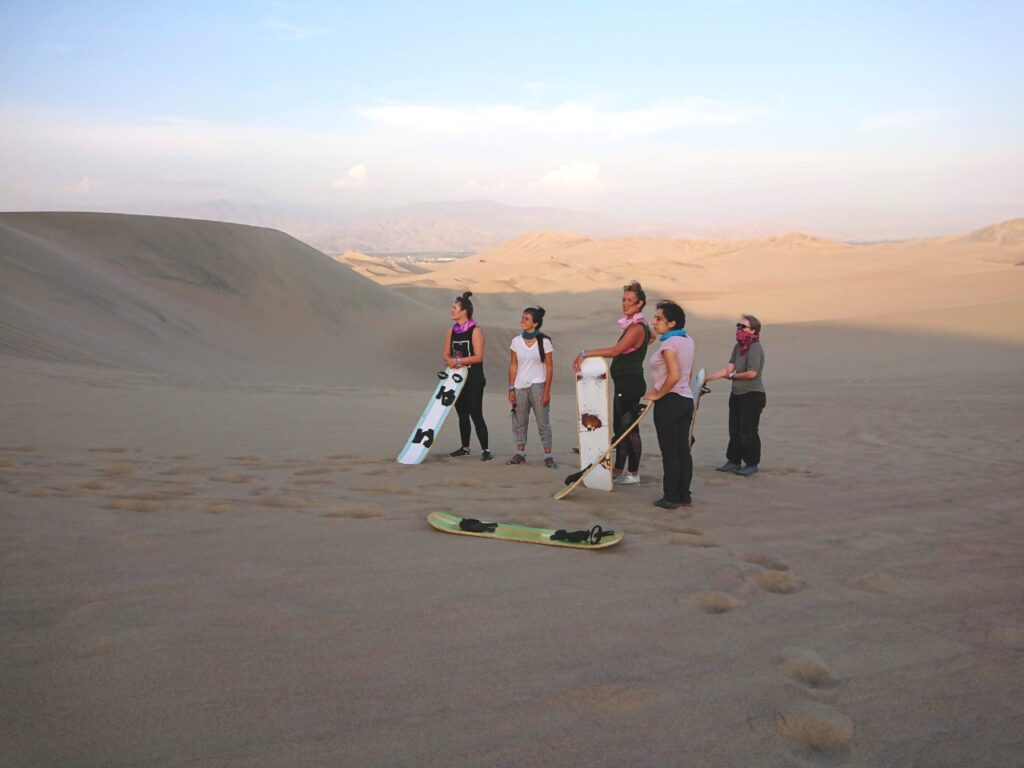
But we didn’t want to be grumpy boring middle-aged types who just complain about the youth who live life and have fun. That is why we surrendered and went desert racing. For an hour, a myriad of big noisy sand buggies raced around up and down steep dunes. All around, people “surfing” down steep slopes – most people lying on sandboards (the same as a snowboard). It all ended with a beautiful sunset.
And to make a long story short, that day we put a really big climate footprint in the sand before darkness fell. But it was great fun!
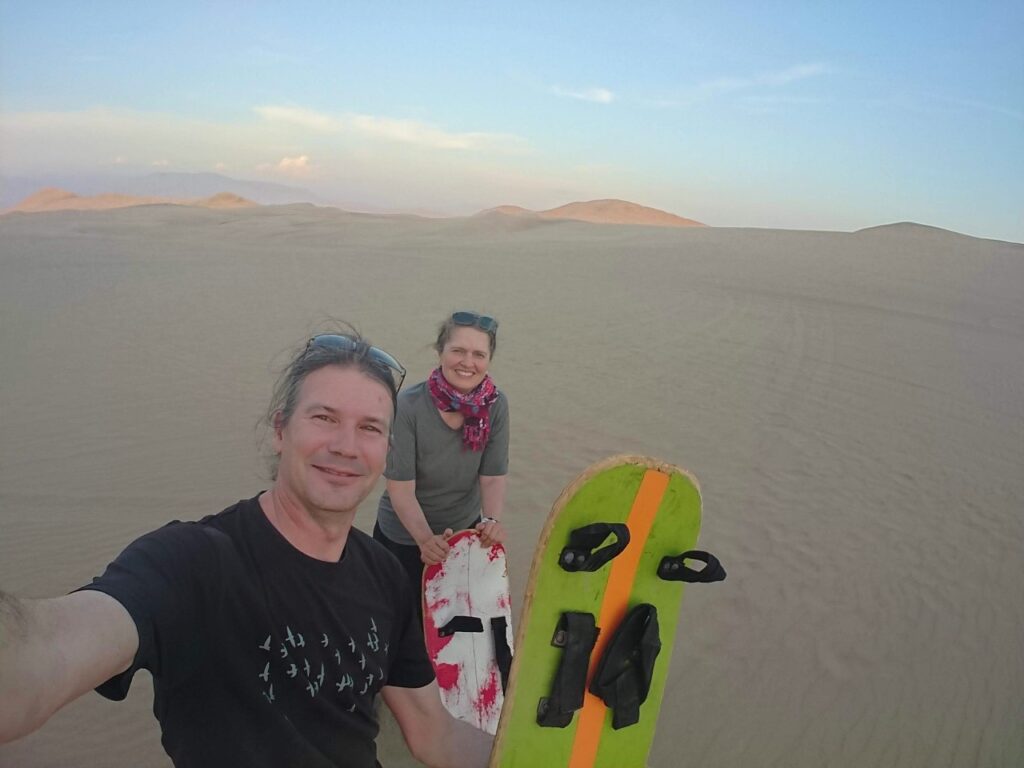
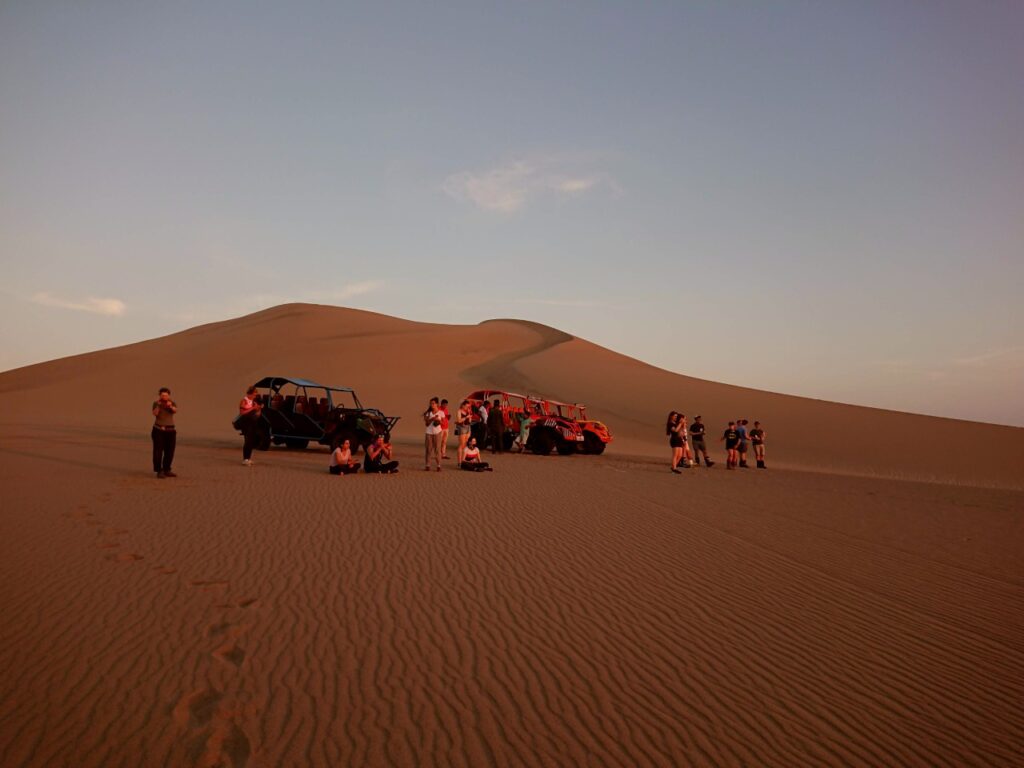
Pisco sour and some mysterious lines
The next day, after an hour’s delay, we traveled from Huacachina towards the “white city” – Arequipa. The delay and the minibus were due to the aforementioned overbooking, but that just meant we had time for a swim in the pool.
After a 15 minute drive, we had the first stop of the trip: guided tour and pisco tasting at a distillery in the town of Ica. Pisco sour is an alcoholic cocktail of Peruvian origin that you can get everywhere in Peru.
After the tour, where we got an insight into the manufacturing process, we were lined up in front of the bar. It was time for the tasting. In addition to tasting different kinds of pisco sour, we also tasted pisco wine. The quality of the drinks varied, but we were glad we weren’t the ones behind the wheel for the next many hours.
It was a very dry and monotonous desert landscape we drove through. In some places along the route, there were some who optimistically tried to cultivate the land. But it looked hopeless, and it didn’t make it any better that there was garbage lying everywhere.
A few hours later we had to switch from the minibus to a large double-decker bus. We were parked in the middle of nowhere. The landscape was still dry and barren. The other bus had not yet arrived, which meant we had time to stretch our legs.
However, it wasn’t just anywhere in the middle of nowhere. We were in the Nasca desert. The place with the mysterious lines on the ground – the famous Nasca lines.
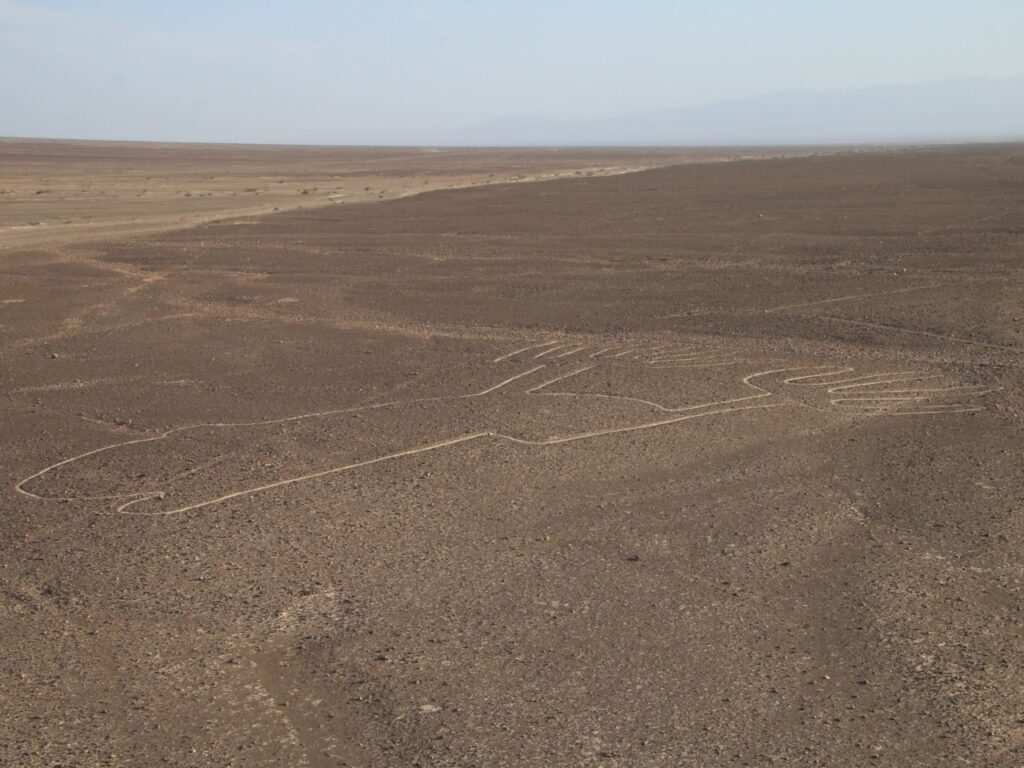
The summer residence of the Inca elite
In Cusco, the historic capital of the Incas, we said so long and thank you for the trip and “hopped” off Peru Hop. And even though we spent several days in Cusco, we never got around to pick up the free Peru Hop t-shirts from the company’s office.
It had taken two very long stages by bus to arrive. Along the way we had spent some days in Arequipa. There aren’t many birds here, so for us, it was just a stop on the tourist route.
There are also many tourists In Cusco. As mentioned, it was the capital of the Incas, which naturally attracts tourists. But Cusco is also the city you have to go through to experience Peru’s absolute biggest tourist attraction – Machu Picchu.
Machu Picchu, listed on UNESCO’s World Heritage List in 1983, was built as a refuge for the Inca elite – a kind of summer residence for the leaders. I think almost all tourists who have been there have pictures of the iconic view, where you look down on the ruins. And even before we started our travels, we had decided to visit Machu Picchu. In addition to the historical significance, the mountains and valleys around it are actually an excellent birding area.
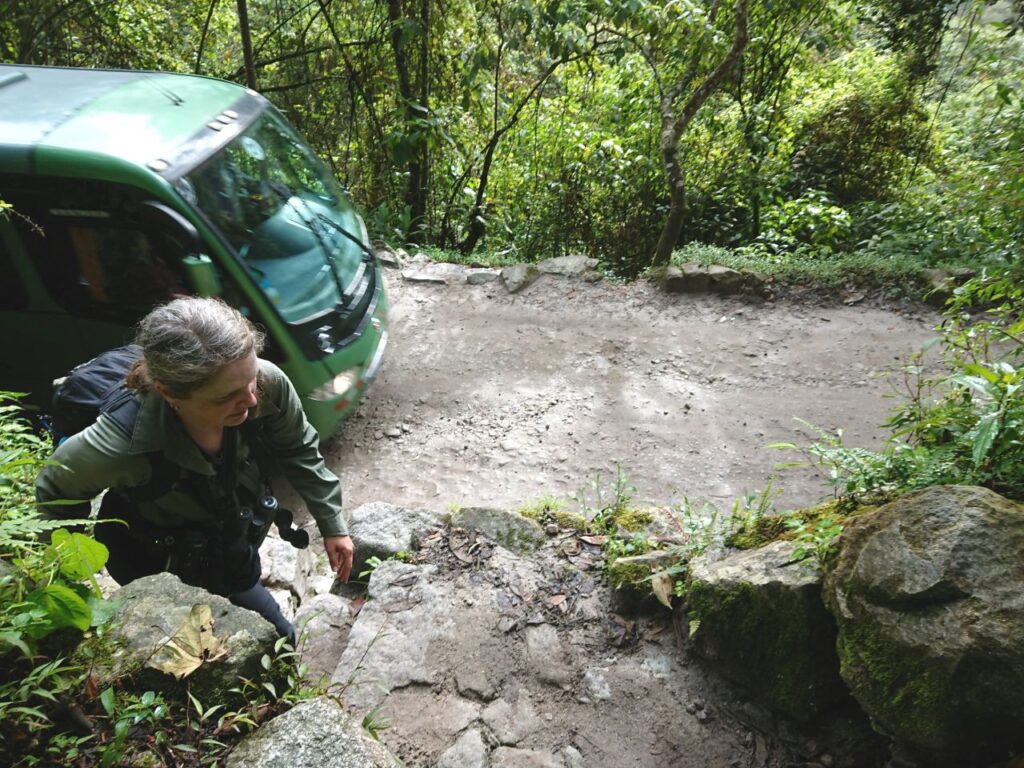
Our visit fell outside the peak season and that is probably a good thing – because there were many people – so it must be really overcrowded during the peak season, even though a quota system has been introduced for entering the ruins. During the peak season there must be a lot of congestion – not just at Machu Picchu itself – but also in the small town of Aqua Calientes at the foot of Machu Picchu and on The Inca Trail.
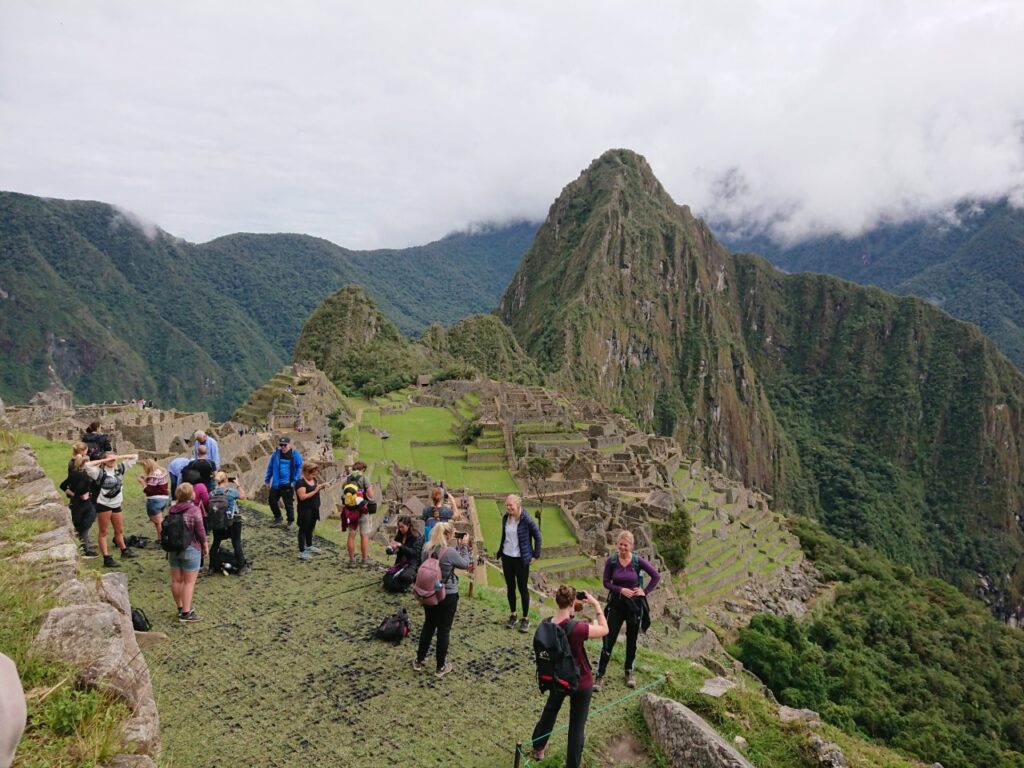
The Fly in the ointment
But there are also challenges, which is why there is also a fly in the ointment. The massive tourism is wearing the area and the surroundings. Despite the quota system, many more visitors are let in daily than recommended by UNESCO. And it will only get worse in the future, as there are still plans to build an airport very close to Machu Picchu. The number of visitors is expected to rise from around 1.5 million to around 3 million visitors annually.
Such a massive increase can have consequences – not only for Machu Picchu itself, but also for the locals and nature. It is a situation full of dilemmas and many articles can be written about the subject – something we might come back to at another time. But you can read about it in an article in Danish newspaper Politiken (in Danish): Ny Machu Picchu lufthavn: Unesco frygter for ruinbys fremtid or in this article in The Guardian: ‘It would destroy it’: new international airport for Machu Picchu sparks outrage ).
We got to see Machu Picchu and it is a beautiful and impressive place. And the iconic view didn’t disappoint either, and it was almost as if we had been there before.
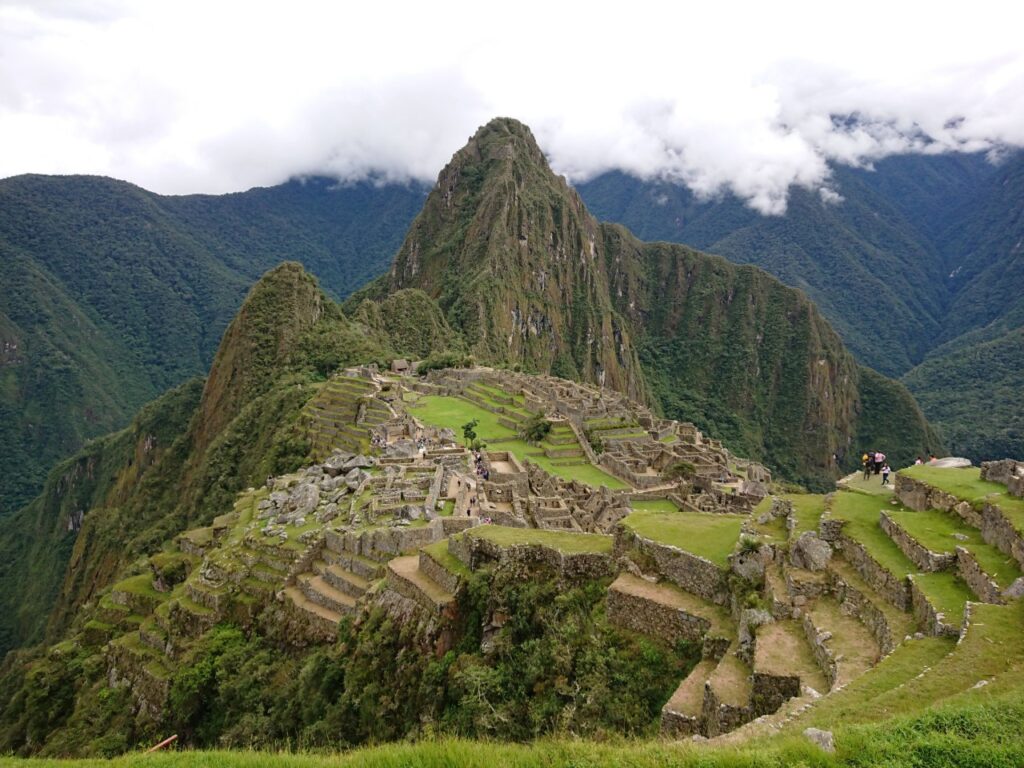
All photos © Bente Steffensen and Uffe Damm Andersen, unless otherwzie stated.

